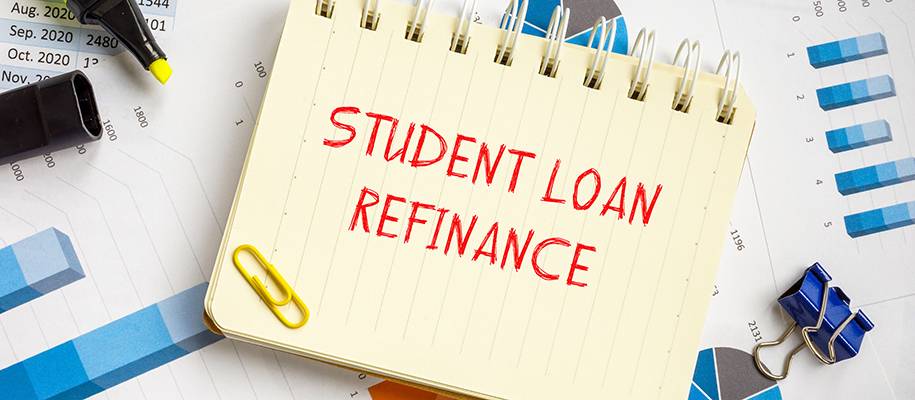If you’ve decided to get a handle on your student loans, you’ve already achieved a major feat. Nearly two-thirds of the Class of 2018 graduated with student loan debt, according to the Institute for College Access & Success. But not every graduate, or parent, considers how to make their student loan payments manageable. Refinancing is an option that some graduates can turn to, but how does it work?
Loan refinancing
When you refinance student loans, a private lender pays off your previous loans and issues you a new one at a lower interest rate. This can save you money over time, but it’s not an ideal option for every borrower. Variable interest rates can be enticing, but student loan refinancing lenders are willing to extend the lowest rates to you only if you meet relatively strict eligibility requirements. You must also be prepared to pay off your refinanced loan without access to a wide array of repayment benefits. That’s because refinancing is generally aimed at financially stable borrowers who likely won’t need them. The strict qualifications and loss of certain benefits mean some graduates are better off pursuing alternatives, like federal payment-reduction programs. Here are five reasons why refinancing might not be your best bet.
Related: Types of Student Loans Explained: Federal vs. Private
1. You must have at least good credit or a cosigner
To qualify for student loan refinancing, you typically need to have good or excellent credit. In the commonly used FICO credit scoring model, this corresponds to a credit score of 670 or higher. The closer your score is to the maximum of 850, the lower the interest rate you’ll receive. You must also earn a stable income and have enough cash flow per month to afford payments. This protects the lender from the possibility that you won’t repay the loan as agreed. If you don’t meet the requirements on your own, you can use a cosigner who will be responsible for paying your loan bill if you can’t. Many recent college graduates who are building their credit won’t qualify for refinancing alone. If you don’t have access to a cosigner who is willing to work with you, consider waiting to refinance until your credit has improved.
2. You’ll lose access to income-driven repayment
Income-driven repayment is a benefit of federal loans. It’s a set of four repayment plans that allow you to lower federal loan payments to a portion of your income. You could also receive forgiveness on the remaining balance after 20 or 25 years of payments, depending on the plan. Consider leaving federal loans out of your refinance plan so you can maintain access to income-driven repayment. It can be beneficial if you lose your job or work in a field that pays too little to comfortably afford your loan bills long term.
Related: How Your Degree May Determine Student Loan Payments
3. Your loans won’t be eligible for Public Service Loan Forgiveness
Another worthwhile protection only federal loans offer is Public Service Loan Forgiveness (PSLF). This program provides tax-free loan forgiveness to borrowers who work for government agencies or certain nonprofits and make 120 qualifying student loan payments. If you work in a field where you’re eligible for PSLF, avoid refinancing your federal loans. That goes for parent borrowers with PLUS loans too. If you’re unsure whether you’re a good candidate for forgiveness, use the Federal Student Aid’s online PSLF Help Tool.
4. You may not be able to postpone payments as long
Federal loans provide generous deferment and forbearance options if you need to take a temporary break from loan payments. For instance, if you’re unemployed, you may qualify for up to three years of loan deferment without paying interest on your subsidized loans, which keeps your balance from growing. When you refinance, lenders typically offer shorter payment deferment periods. It’s common for a student loan refinance lender to provide only 12 months of forbearance over the course of your entire loan term.
5. You may forfeit a student loan grace period
Federal student loans (and some private loans) provide a six-month grace period after you graduate during which you don’t have to make loan payments. Once you refinance, you generally must begin making payments right away. Avoid refinancing before your grace period ends. It could give you a needed break as you search for employment or create a budget before your loans are due.
Related: Don’t Fret the Debt: 5 Ways to Conquer Student Loans
How to decide what’s right for you
Refinancing high-interest private loans is often a safe bet, but when considering whether to roll in federal loans when refinancing, consider whether you may need these loan protections in the future. Take into account your loan types and your goals. If you’re aiming for a lower interest rate, compare quotes from multiple lenders and make sure you stand to save money by refinancing.
Finally, choose the shortest repayment term you’re able to afford to ensure you save the most interest possible. If you have five years left to repay loans, choosing a 10-year refinance term means losing out on potential interest savings. Refinancing can make loan repayment more seamless, but only if it’s the right move for you.
Are you currently still in college? Use our Scholarship Search tool to avoid refinancing headaches in the future.




